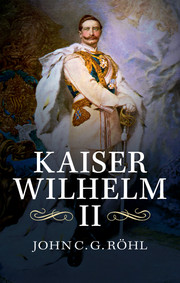Book contents
- Frontmatter
- Dedication
- Contents
- List of figures
- Acknowledgements
- Preface to the English edition
- Preface to the German edition
- Acknowledgements
- Overview: Wilhelm the Last, a German trauma
- Part I 1859–1888: The Tormented Prussian Prince
- Part II 1888–1909: The Anachronistic Autocrat
- 6 Divine right without end
- 7 Bismarck’s fall from power (1889–1890)
- 8 The establishment of the Kaiser’s personal monarchy (1890–1897)
- 9 The Chancellor as courtier: the corrupt Bülow system (1897–1909)
- Part III 1896–1908: The Egregious Expansionist
- Part IV 1906–1909: The Scandal-Ridden Sovereign
- Part V 1908–1914: The Bellicose Supreme War Lord
- Part VI 1914–1918: The Champion of God’s Germanic Cause
- Part VII 1918–1941: The Vengeful Exile
- Notes
- Index
9 - The Chancellor as courtier: the corrupt Bülow system (1897–1909)
Published online by Cambridge University Press: 05 September 2014
- Frontmatter
- Dedication
- Contents
- List of figures
- Acknowledgements
- Preface to the English edition
- Preface to the German edition
- Acknowledgements
- Overview: Wilhelm the Last, a German trauma
- Part I 1859–1888: The Tormented Prussian Prince
- Part II 1888–1909: The Anachronistic Autocrat
- 6 Divine right without end
- 7 Bismarck’s fall from power (1889–1890)
- 8 The establishment of the Kaiser’s personal monarchy (1890–1897)
- 9 The Chancellor as courtier: the corrupt Bülow system (1897–1909)
- Part III 1896–1908: The Egregious Expansionist
- Part IV 1906–1909: The Scandal-Ridden Sovereign
- Part V 1908–1914: The Bellicose Supreme War Lord
- Part VI 1914–1918: The Champion of God’s Germanic Cause
- Part VII 1918–1941: The Vengeful Exile
- Notes
- Index
Summary
In the summer of 1897 Wilhelm II appointed to high office two men who could hardly have been more different from each other in character, but who embodied the rift in his own personality and were to have a decisive influence on the middle years of his reign. One was the Machiavellian diplomat and courtier Bernhard von Bülow, whom the Kaiser made Secretary of State at the Foreign Office and who in 1900 (as had long been intended) was to become Reich Chancellor. The other was a ‘Renaissance figure’ – more the condottiere – of a different kind, the power-conscious technocrat and battlefleet fanatic with ‘the Bismarck touch’, Admiral Alfred von Tirpitz, who became Secretary of State at the Reich Navy Office that summer and was to remain in the post until 1916.
Bülow’s promotion to ambassador in Rome in 1893, Secretary of State for foreign affairs in 1897 and Reich Chancellor and minister-president of Prussia in 1900 was the work of the Kaiser’s favourite, Count Philipp zu Eulenburg, whose influence on Wilhelm II in these years it is hard to overstate. Eulenburg had emerged as the clear winner from the small group of secret advisers around the Kaiser in his conflict with Bismarck. The Grand Duke of Baden withdrew from Reich politics and contented himself with issuing occasional admonitions from Karlsruhe. Waldersee was replaced by the famous Count Alfred von Schlieffen as chief of the General Staff in 1891 because he had had the nerve to criticise the Supreme War Lord’s conduct of manoeuvres, and Adolf Freiherr Marschall von Bieberstein wore himself out in parliamentary battles and court intrigues. At first Eulenburg worked closely with the eccentric recluse Geheimrat Fritz von Holstein to keep the hard-pressed Caprivi afloat. Since 1894, however, the Kaiser’s intimate friend (Wilhelm addressed him with the familiar Du) had gone his own way. Eulenburg and Holstein parted company above all in their conception of the role to which Wilhelm II was entitled in formulating German policy.
- Type
- Chapter
- Information
- Kaiser Wilhelm IIA Concise Life, pp. 63 - 70Publisher: Cambridge University PressPrint publication year: 2014



